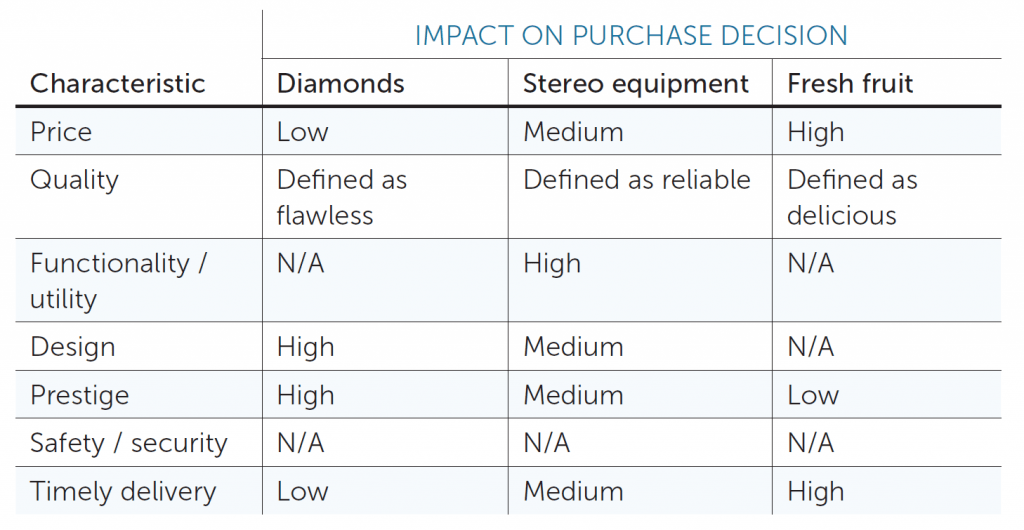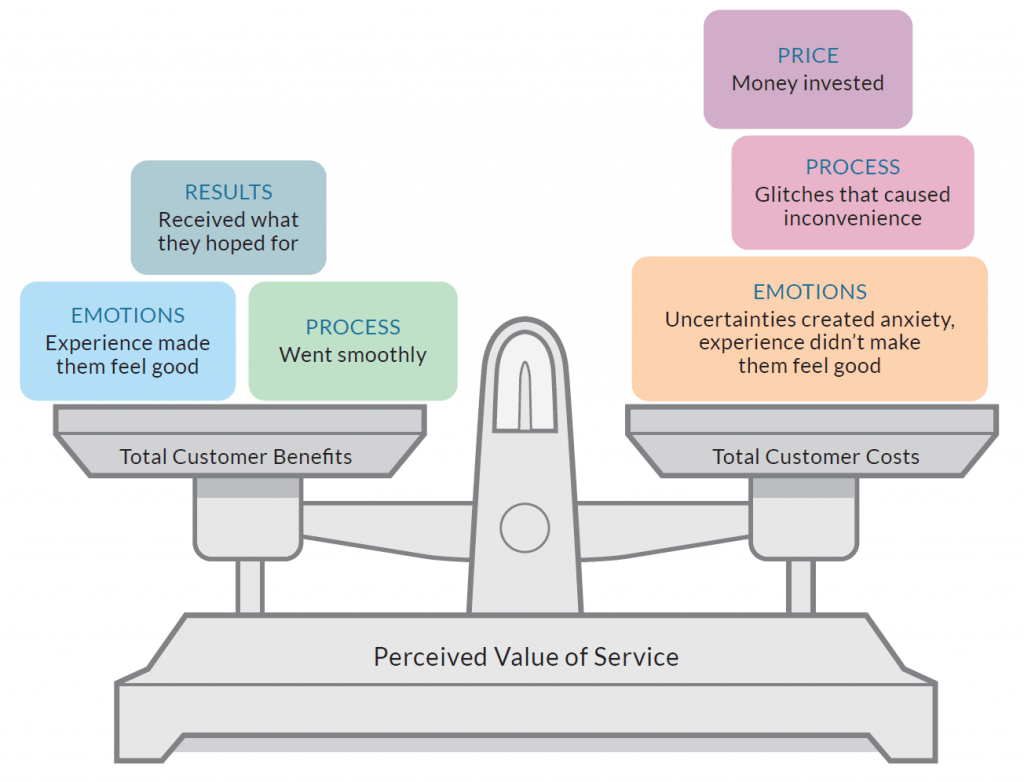
Perceived Value of Products
Enhancing the marketing effort means increasing the value that the customer perceives in the product or service offered. Since the customer determines value, the customer is where organizations should start when considering how to improve the perceived value.
The approach that an organization takes for perceived value depends on the nature of the product or service offered. The chart below illustrates how three different products have distinct combinations of characteristics that have low, medium or high impact on customers’ purchasing decisions. For example, the most influential characteristics of diamonds are design and prestige. Customers that value design and prestige are more likely to buy diamonds that those who place more value on different product characteristics such as function or utility.
The Impact of Different Characteristics on Purchase Decisions
Once marketers have researched the motivations and values of customers in a specific international market, the next step is to adapt what they sell and how they sell it to match their preferences. Enhancing value can mean changing the product to give it new features or a different design. In other cases, it can mean changing how the product is sold.
Want to learn more about planning and implementing marketing strategies? Check out the FITTskills Marketing Products and Services online workshop!
10 product characteristics and features to highlight to customers
- Quality: Emphasize the number of satisfied customers or the durability of the service/product. Offer warranties or after-sales service to demonstrate that the organization stands behind the service/product.
- Functionality: Inform the target market about different ways of using the product. A campaign for orange juice argued, “It’s not just for breakfast anymore”.
- Design: New packaging or different colours may satisfy this concern. Alternatively, the organization may need to modify the appearance of the product.
- Prestige: Sell the product at a high price through an exclusive retail outlet. Emphasize the intelligence or taste of people who buy the product.
- Safety/security: Emphasize that the product conforms to health or safety standards or that it has performed better than the competition on tests.
- Timely delivery: Design your distribution chain so that the product always arrives when it “absolutely, positively has to be there”.
- Ease of assembly or maintenance: Perform partial assembly before the sale, provide written instructions with the product and offer to help purchasers with assembly.
- Delivery to a specific location: Develop a delivery system that brings the product where the customer wants it. A key value for pizza restaurants is the ability to bring the product to the customer’s home.
- Ambiance at the point of purchase: Sell your product in a fashionable boutique setting.
- Price: Use a big-box store format to move huge volumes while
incurring minimal overheads.
Perceived Value of Services
The intangible nature of services can make them more difficult to sell. Service providers need to understand how customers assess services. One way marketers can do this is to understand the relationship between perceptions and expectations. This relationship has been described as:
Satisfaction = Perceived Value – Expectation
If customers perceive that an experience has exceeded their expectations, the customer is satisfied. If customers perceive that an experience has not met their expectations, then the customer is dissatisfied.
Not all customers are the same. Their culture, life experiences, age and other characteristics cause great variation in perceptions and expectations. For service providers, this means that they need to understand customer expectations in the target market. Understanding expectations allows organizations to set a benchmark for perceived value that will result in customer satisfaction.
Although each customer’s perception of value is unique, aspects of perception can be objectified and business strategies used to address issues.
For example, if customers consistently stand in line to wait for service, then they would likely perceive shorter waiting times as valuable. The service provider could influence the perceived value of their service by adding additional staff to reduce waiting times. However, customers vary and what might be considered a short wait for some may be too long for others.
The numerator of this equation includes what the customer receives from experiencing the service. Results are the outcomes, what the customer hopes to obtain from using the service. The process refers to the factors of delivery, e.g. wait times, information provided, the interaction. Emotional value is what the customer feels about the service, brand or the event when experiencing it.
The denominator is the cost of the service to the customer. In addition to the monetary cost of the service paid by the customer, there is also the cost of any inconvenience, such as wait times, parking or delays. Uncertainties are the cost of the unknown—what the customer is unsure of in relation to the service—and they can cause anxiety.
Service providers can influence these factors using business strategies. For example, costs can be controlled to ensure prices are reasonable for the customer, contingency plans can be put in place for inconveniences, and money-back guarantees offered to reduce uncertainty. Meeting the customer’s expectations for results and process also increases the emotional value of the service.
The chart below shows the factors that contribute to the benefits and costs that influence how a customer views the value of a service. Ideally, the “Total Customer Benefits” outweigh the “Total Customer Costs”, creating an overall positive perception of the service.
Customer’s Perceived Value of Service
By defining the customer, assessing customer satisfaction and determining the perceived value of the service, the service provider can identify the selling points for the service being offered. This information helps service providers adapt and customize their services and develop their value propositions.








disqus comments